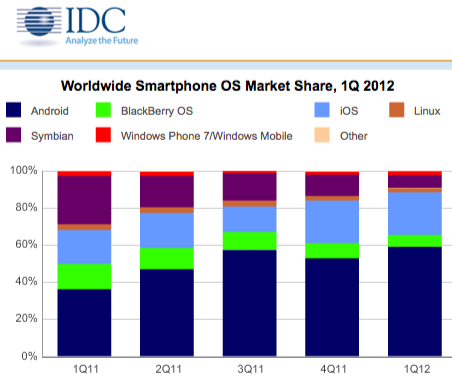[Techtaffy Newsdesk]
Smartphones powered by the Android and iOS mobile operating systems accounted for more than eight out of ten smartphones shipped in the first quarter of 2012 (1Q12). According to the International Data Corporation (IDC) Worldwide Quarterly Mobile Phone Tracker, the mobile operating systems held shares of 59.0% and 23.0% respectively of the 152.3 million smartphones shipped in 1Q12. During the first quarter of 2011, the two operating systems held a combined share of 54.4%. The share gains mean that Android and iOS have successfully distanced themselves from previous market leaders Symbian and BlackBerry, as well as Linux and Windows Phone 7/Windows Mobile.
“In order for operating system challengers to gain share, their creators and hardware partners need to secure developer loyalty,” said Kevin Restivo, senior research analyst with IDC’s Worldwide Mobile Phone Tracker program. “This is true because developer intentions or enthusiasm for a particular operating system is typically a leading indicator of hardware sales success.”
Operating System Highlights
Android finished the quarter as the overall leader among the mobile operating systems, accounting for more than half of all smartphone shipments. In addition, Android boasted the longest list of smartphone vendor partners. Samsung was the largest contributor to Android’s success, accounting for 45.4% of all Android-based smartphone shipments. But beyond Samsung was a mix of companies retrenching themselves or slowly growing their volumes.
iOS recorded strong year-over-year growth with sustained demand for the iPhone 4S following the holiday quarter and the addition of numerous mobile operators offering the iPhone for the first time. Although end-user demand remains high, the iPhone’s popularity brings additional operational pressures for mobile operators through subsidy and data revenue sharing policies.
Symbian posted the largest year-over-year decline, a result driven by Nokia’s transition to Windows Phone. But even as Symbian volumes have decreased, there continues to be demand for the OS from the most ardent of users. In addition, Nokia continues to support Symbian, as evidenced by the PureView initiative on the Nokia 808. Still, as Nokia emphasizes Windows Phone, IDC expects further declines for Symbian for the rest of this year.
BlackBerry continued on its downward trajectory as demand for older BlackBerry devices decreased and the market awaits the official release of BB 10 smartphones later this year. In addition, many companies now permit users to bring their own smartphones, allowing competitor operating systems to take away from BlackBerry’s market share. Although RIM has not officially released BB 10, initial glimpses of the platform have shown improvement.
Linux maintained its small presence in the worldwide smartphone market, thanks in large part to Samsung’s continued emphasis on bada. By the end of the quarter, Samsung accounted for 81.6% of all Linux-powered smartphones, a 3.6% share gain versus the prior-year period. Other vendors, meanwhile, have been experimenting with Android to drive volume. Still, Linux’s fortunes are closely tied to Samsung’s strategy, which already encompasses Android, Windows Phone, and later this year, Tizen.
Windows Mobile/Windows Phone has yet to make significant inroads in the worldwide smartphone market, but 2012 should be considered a ramp-up year for Nokia and Microsoft to boost volumes. Until Nokia speeds the cadence of its smartphone releases or more vendors launch their own Windows Phone-powered smartphones, IDC anticipates slow growth for the operating system.


